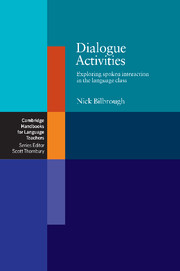Book contents
- Frontmatter
- Contents
- Thanks and acknowledgements
- Introduction
- 1 Understanding
- 2 Analysing
- 3 Reproducing and reconstructing
- 4 Memorising
- 5 Rehearsing and performing
- 6 Co-constructing
- 7 Creating and personalising
- 8 Communicating
- 9 Dialogue as learning
- Dialogue Bank A From the film Mulholland Drive
- Dialogue Bank B Authentic snippets
- Dialogue Bank C Snippets from fairy tales
- Dialogue Bank D Lame jokes
- Dialogue Bank E Situational dialogues
- Dialogue Bank F ‘Dating Agency’ from the comedy series Little Britain
- Further reading and resources
- Index
9 - Dialogue as learning
Published online by Cambridge University Press: 06 July 2010
- Frontmatter
- Contents
- Thanks and acknowledgements
- Introduction
- 1 Understanding
- 2 Analysing
- 3 Reproducing and reconstructing
- 4 Memorising
- 5 Rehearsing and performing
- 6 Co-constructing
- 7 Creating and personalising
- 8 Communicating
- 9 Dialogue as learning
- Dialogue Bank A From the film Mulholland Drive
- Dialogue Bank B Authentic snippets
- Dialogue Bank C Snippets from fairy tales
- Dialogue Bank D Lame jokes
- Dialogue Bank E Situational dialogues
- Dialogue Bank F ‘Dating Agency’ from the comedy series Little Britain
- Further reading and resources
- Index
Summary
In recent years there has been a greater emphasis on a learner-centred approach to learning languages. Sometimes this has meant that teachers have felt uncomfortable about talking freely with their students because they believe that by doing so they are cutting back on opportunities for student-to-student interaction. Another way of looking at learner-centredness is to place the teacher on an equal footing with the learners, as someone who engages with them in dialogue (as opposed to an outsider who merely controls the proceedings). An approach which takes this viewpoint will allow plenty of opportunities for dialogue between the learners and the teacher, alongside learner-to-learner dialogue, because it acknowledges that interaction between proficient and less proficient speakers can provide a rich source of learning.
Learners generally expect to have a language teacher who is a more advanced speaker than they are themselves, and this difference in level should be exploited as much as possible. If the language teacher's only role is to present new language and to set up student-to-student interaction in order to practise this language, then a valuable opportunity to engage in dialogue with the learners, and thereby both to support and to challenge their language development, is potentially lost.
Teachers, with their advanced language skills, are able to consciously adjust their language as they interact with the learners, bringing more complex or simpler language into play where appropriate.
- Type
- Chapter
- Information
- Dialogue ActivitiesExploring Spoken Interaction in the Language Class, pp. 196 - 221Publisher: Cambridge University PressPrint publication year: 2007



